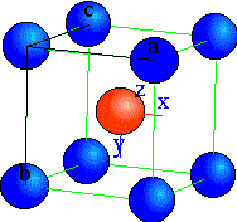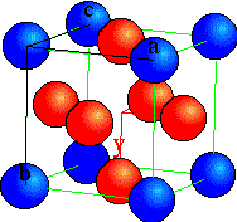

| MadSci Network: Engineering |
Message:
If you were to look at most solids, you would find
that the atoms are arranged in regular patterns. Two such 3D patterns
are shown below. In the case of pure iron at room temperature,
the atoms have what metallurgist
coe/mateng/what.html">metallurgist
call a body centered cubic or BCC array. Imagine a cube with iron atoms
centered at the corners and the center of the cube. Another common array
for metals is face centered cubic or FCC. In the FCC crystals the atoms
are at the corners and the centers of the cube faces. Copper has
an FCC structure.
 |
 |
What happens though is there are defects in the patterns. There are point defects which involve a single atom. An example would be a vacancy. Here there is no atom where there should be one. The other atoms rearrange themselves to accommodate the missing atom. This results in a disruption of the regular pattern of atoms. If you can imagine a cube of taffy that someone grabs by one corner and pulls, that is what the new pattern of atoms looks like if there is a vacancy at one of the cube corners.
There are also line defects metallurgist call dislocations. There are two types of dislocations; edge and screw. Imagine looking down on the atoms in a cubic array. If they are perfectly aligned, you would see a series of squares. What commonly happens is an extra plane of atoms gets inserted into the array. This forces apart the atoms in the area where the extra atoms occur. At the edge of the plane the atoms form a trapezoid (a rectangle with one extra long side). This type of dislocation is called an edge dislocation.
The screw dislocation is harder to visualize, but if you can imagine a larger number of cubes with a spiral staircase in the middle, you have a pretty good idea of what it looks like.
Why are dislocations so important? The movement of dislocations in the metals is how metals plastically deform at room temperature. By plastic deformation, we mean permanent changes in shape much like what occurs with clay when you push or pull on it. Dislocations can move much more easily than atoms. As a result, the force needed to deform a metal is much, much less than would be needed if there were no dislocations.
At absolute zero (0 K, -273°C, -459°F) all motion of atoms stops and the atoms assume absolutely perfect arrangements with no dislocations or vacancies. At this point the substance is as strong as it will ever be. But can dislocations and other defects be eliminated at higher temperatures? Remember the screw dislocations? It turns out that very fine fibers of iron and other elements can be grown with a single screw dislocation at their core. Imagine a spiral staircase again with atoms of iron at the center and the corners of the stair treads. That is what the atoms look like in these fibers. With a single dislocation, these fibers approach the maximum strength that physicist calculate the metals would have if the atoms were forced to move. For iron, these fibers have strengths of more than 1,000,000 pounds per square inch (psi).
As far as commercial applications go, not much work is being done with iron fibers. There are some ceramic fibers for aerospace applications that are grown with only one or two dislocations. Carbon and especially graphite fibers have very few dislocations as well. Their most common application is in composites such as carbon-carbon composites.
Will they be used in the future? That is really an engineering question. The first problem is the size of the fibers. Their diameter is much smaller than that of a human hair. So while they are strong, the amount of weight they can support is not large. If they can be made larger, say the size of an individual strand you see in a stranded copper wire, without having any defects added then they could support significant loads. The fibers also tend to be very short, only a few centimeters long at best. That is why they are often called whiskers. For most applications they would have to be much longer.
The second problem is the relative cost of the fibers. Does it make sense to use a $15,000 fiber when you can design a wire to do the same job that cost $5? The cost of these fibers would have to be greatly reduced before they can be used.
The third major hurdle is the need to protect the fibers from the environment. If you put a typical steel nail outside for a few days, it will rust. The fibers would do the same thing. They also loose a lot of their strength if they are nicked or their surface is damaged in any way. In real life, the problem of protecting the fiber will probably outweight the benefits of using the fiber.
So, in summary, extremely strong iron fibers are a reality. They have only a single defect at their core. They could be made and used, but compared to other available materials today they are too small, cost too much and are too easily damaged. In the future the problems may be overcome, and the fibers could see significant usage.
Try the links in the MadSci Library for more information on Engineering.